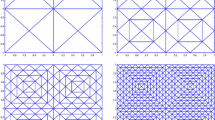Abstract
In this paper, a finite element method using bivariate spline on domains is proposed for solving linear hyperbolic equations in two-dimensional spaces. Bivariate spline space \(S_{4}^{2,3} (\Delta_{mn}^{(2)} )\) is constructed. It not only satisfies homogeneous boundary constraints but also satisfies interpolating boundary conditions on type-2 triangulations. Two examples are shown to confirm the correctness of theoretical conclusions. This means that spline method is efficient and feasible to solve 2D linear hyperbolic equations.





Similar content being viewed by others
References
Biazar, J. (2010). Analytic solution for telegraph equation by differential transform. Physics Letters A, 374, 2904–2906.
Yıldırım, A. (2010). He’s homotopy perturbation method for solving the space- and time-fractional telegraph equations. International Journal of Computer Mathematics, 87, 2998–3006.
Barth, A., & Fuchs, F. G. (2017). Uncertainty quantification for linear hyperbolic equations with stochastic process or random field coefficients. Applied Numerical Mathematic, 121, 38–51.
Karaa, S., & Pani, A. K. (2017). A posteriori error estimates for mixed finite element Galerkin approximations to second order linear hyperbolic equations. International Journal of Numerical Analysis and Modeling., 14(4–5), 571–590.
Abd-Elhameed, W. M., Doha, E. H., Youssri, Y. H., & Bassuony, M. A. (2016). New Tchebyshev–Galerkin operational matrix method for solving linear and nonlinear hyperbolic telegraph type equations. Numerical Methods Partial Differential Equations, 32(6), 1553–1571.
Li, Z., Jieqing, T., Xianyu, G., & Guo, Z. (2018). Generalized B-splines’ geometric iterative fitting method with mutually different weights. Journal of Computational and Applied Mathematics, 329, 331–343.
Christopher, P. (2017). B-splines collocation for plate bending eigenanalysis. Journal of Mechanics of Materials and Structures, 12(4), 353–371.
Alaattin, E., & Orkun, T. (2017). Numerical solution of time fractional Schrödinger equation by using quadratic B-spline finite elements. Annales Mathematicae Silesianae, 31(1), 83–98.
Jalil, R., & Sanaz, J. (2017). Collocation method based on modified cubic B-spline for option pricing models. Mathematical Communications, 22(1), 89–102.
Kai, Q., Wang, Z., & Jiang, B. (2013). A finite element method by using bivariate splines for one dimensional heat equations. Journal of Information and Computational Science, 10(12), 3659–3666.
Ole, C. (2014). Goh Say Song: From dual pairs of Gabor frames to dual pairs of wavelet frames and vice versa. Applied and Computational Harmonic Analysis, 36(2), 198–214.
Annalisa, B., & Carlotta, G. (2017). Adaptive isogeometric methods with hierarchical splines: Optimality and convergence rates. Mathematical Models and Methods in Applied Sciences, 27(14), 2781–2802.
Annalisa, B., & Garau Eduardo, M. (2017). Refinable spaces and local approximation estimates for hierarchical splines. IMA Journal of Numerical Analysis, 37(3), 1125–1149.
Annalisa, B., & Carlotta, G. (2016). Adaptive isogeometric methods with hierarchical splines: error estimator and convergence. Mathematical Models and Methods in Applied Sciences, 26(1), 1–25.
Deepesh, T., Hendrik, S., Hiemstra René, R., & Hughes Thomas, J. R. (2017). Multi-degree smooth polar splines: A framework for geometric modeling and isogeometric analysis. Computer Methods in Applied Mechanics and Engineering, 316, 1005–1061.
Kruse, R., Nguyen-Thanh, N., De Lorenzis, L., & Hughes, T. J. R. (2015). Isogeometric collocation for large deformation elasticity and frictional contact problems. Computer Methods in Applied Mechanics and Engineering, 2296, 73–112.
Wang, R. H., & Li, C. J. (2006). Bivariate quartic spline spaces and quasi-interpolation operators. Journal of Computational and Applied Mathematics, 190, 325–338.
Ding, H. F., & Zhang, Y. X. (2009). A newfourth-order compact finite difference scheme for the two-dimensional second-order hyperbolic equation. Journal of Applied Mathematics and Computing., 230, 626–632.
Acknowledgements
The authors acknowledge the National Natural Science Foundation of China (Grant Nos. 11601056 and 51009017), the Fundamental Research Funds for the Central Universities (Grant Nos. 3132017055 and 3132016314), the National Scholarship Foundation of China.
Author information
Authors and Affiliations
Corresponding author
Rights and permissions
About this article
Cite this article
Qu, K., Zhang, M., Wang, N. et al. Bivariate Spline Finite Element Solver for Linear Hyperbolic Equations in Two-Dimensional Spaces. Wireless Pers Commun 102, 3067–3077 (2018). https://doi.org/10.1007/s11277-018-5326-0
Published:
Issue Date:
DOI: https://doi.org/10.1007/s11277-018-5326-0




